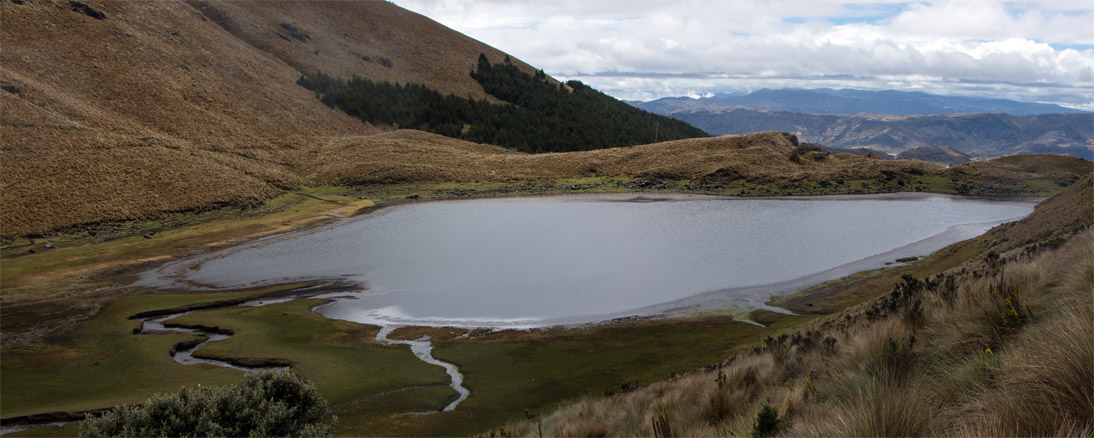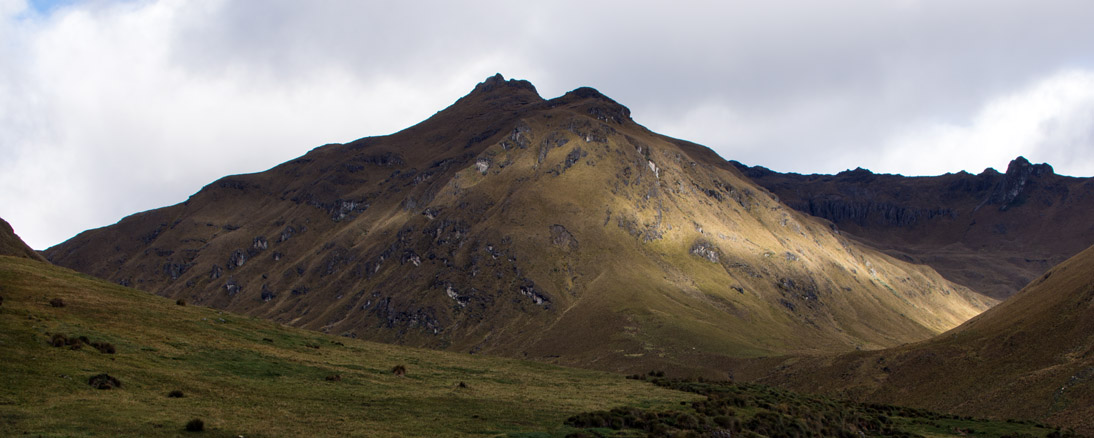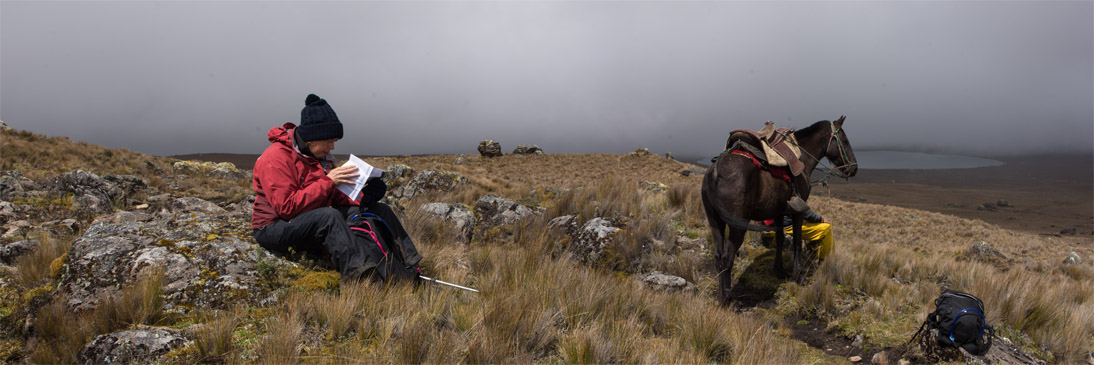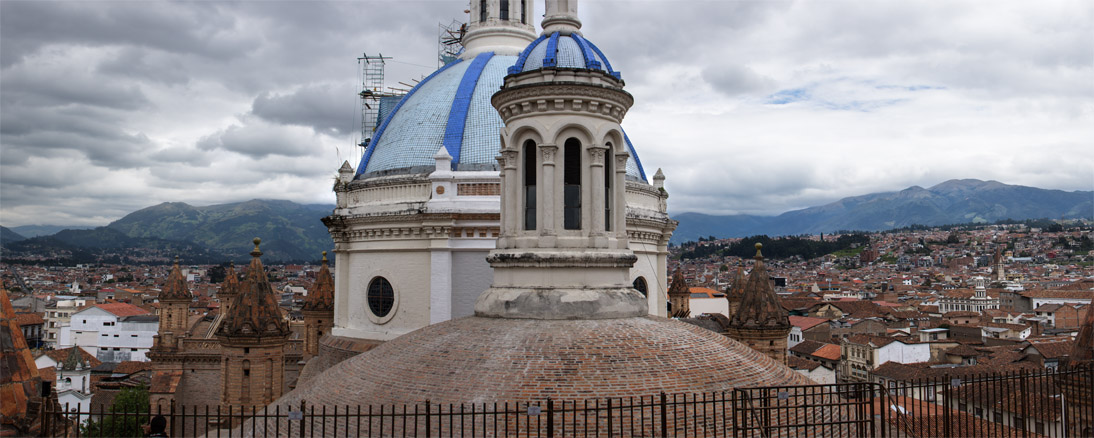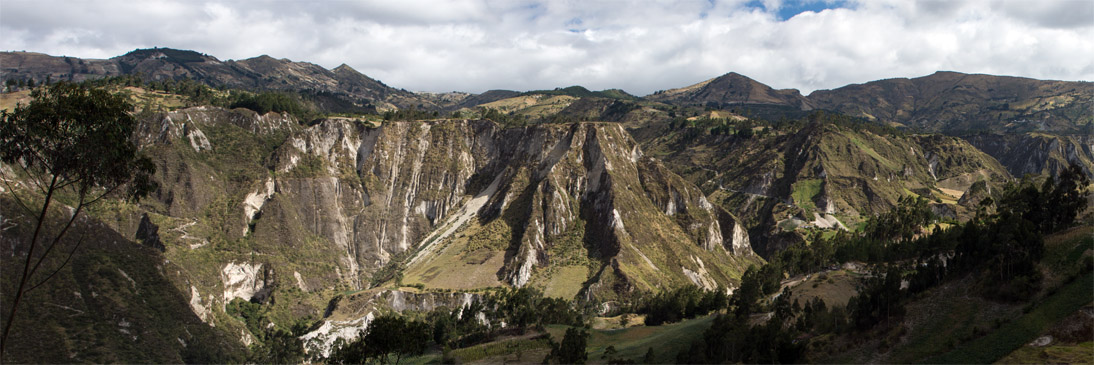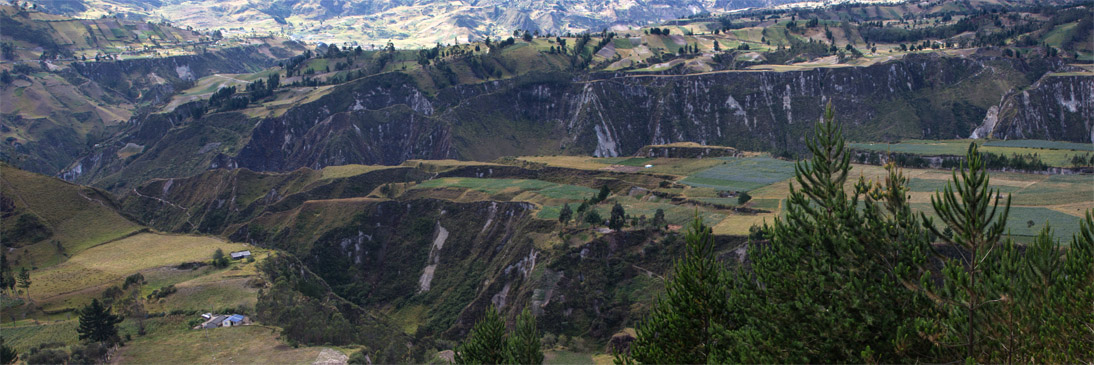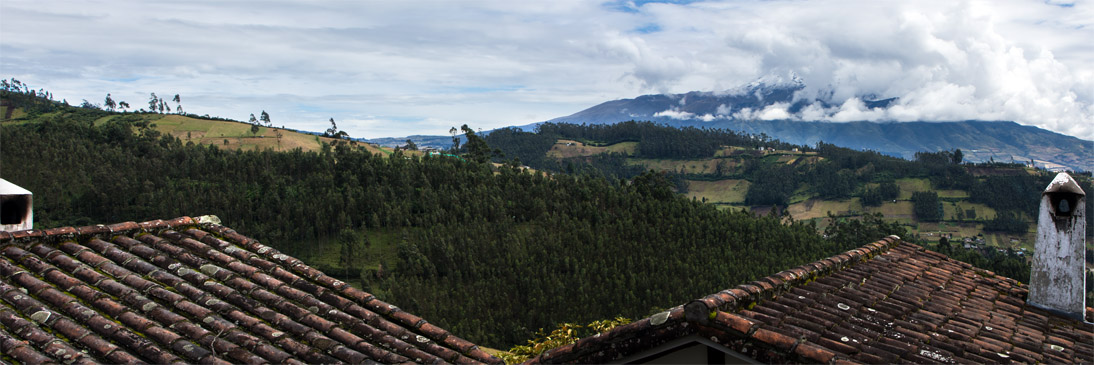Thursday, 19 July 2018
Quito, Pichincha, Ecuador
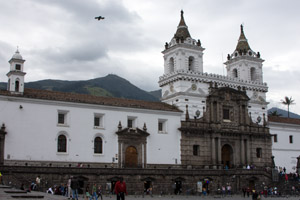
(Quito, Pichincha, Ecuador)
We had decided to try and get to Ecuador in as few flights as possible so had taken the new Eurostar service to Amsterdam the night before. We then got on the plane at 1000 and endured 11 hours of tedious flight, getting to Quito around 1400.
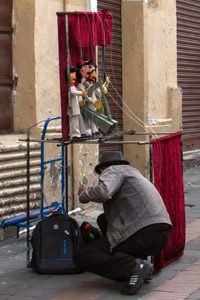
(Quito, Pichincha, Ecuador)
Our hotel was meant to meet us at the airport but had forgotten to ask us our flight number so we just grabbed a regular taxi. The journey to the old town was made more scenic by the taxi driver who decided to avoid the last section of the motorway, and I suspect a toll, by cutting up an almost sheer hill face through a suburb called Guapulo. It was a fairly chic area and when we got to the old town it seemed a bit grubby in comparison.
The hotel was a very nice example of what would prove to be a standard layout for boutique hotels in Ecuador. An old colonial house it had an internal courtyard, once open to the elements now covered with a glass roof. Some rooms, like ours, overlooked the street and others the courtyard. We dumped our stuff, had a shower and headed out for dinner.
After a dinner of some really nice llapingachos and some not so nice beef we went straight to bed in an effort to recover from jet lag. It was not to be the greatest nights sleep. The street our hotel was on turned out to be the red light district of Quito old town and at 0230 some guy started literally sobbing "Puta, Puta" below our window. We managed to get to sleep but then our bodies woke up naturally around 0430.
Friday, 20 July 2018
Quito, Pichincha, Ecuador
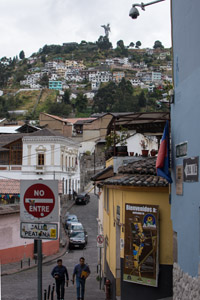
(Quito, Pichincha, Ecuador)
We had a day to see what the town offered so started it with a trip to the National Museum. This turned out to be rather interesting as rather than having hordes of artefacts they had a small well curated selection laid out in a sensible fashion. Sadly there were not many English labels, as they followed the increasingly common approach of relying on audio guides for explanation.
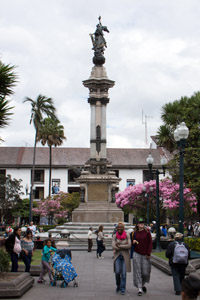
(Quito, Pichincha, Ecuador)
The only problem with the small selection was we finished a lot earlier than we thought. So we headed into the Mariscal district for a look and a coffee break. The Mariscal is a slightly tatty district which houses most of the budget travellers and a lot of the town's night life.
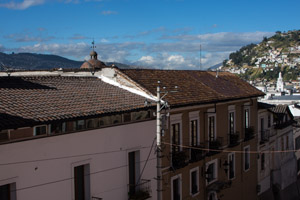
(Quito, Pichincha, Ecuador)
After that we walked back through the old town following a route suggested by our guide book. One thing that is both charming and exhausting about Quito is that it covers a series of fairly steep hills so at 2500m altitude you often find yourself out of breath. All good practice for our upcoming trek. We stopped off at Dios no Meure for lunch, a restaurant built into the walls of a 17th century monastery where a native of Louisiana serves up po boys and hamburgers and some of the nicest beer we found in Ecuador.
The later half of our walking tour was much more packed with a walk through the Ronda, a very atmospheric alleyway full of tourist trinkets; and a look at two of Quito's squares including the Iglesia de San Francisco. The most impressive cathedral was the 17th century Compañía de Jesús, with its ornately carved and gilded interior it took 160 years to build.
For reasons that defy explanation we had to switch hotels that afternoon and did that prior to going out for the evening. That night we had a special treat we started with a cocktail in the Z bar nestled on a small hill with a great view over the twinkling lights of Quito. This was followed up by dinner at Zazu, Quito's finest dining restaurant. This was definitely an experience and not particularly expensive for the standard of cooking.
Saturday, 21 July 2018
Riobamba, Chimborazo, Ecuador
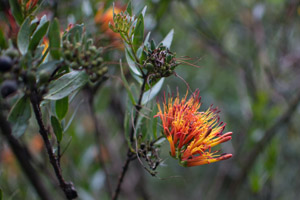
(Chugchilán, Cotopaxi, Ecuador)
We got up relatively early and headed for the bus station 15km south of the centre. Here we caught a bus to Riobamba four hours South of Quito. The journey was quite overcast so we did not see any of Ecuador's famous volcanoes, but we were amazed by how green the country was.
We arrived at Riobamba at around 1300 and checked into another courtyard based hotel. In this case we had been warned that external rooms were noisy so we had booked an internal room, only to find that meant no windows, but it did prove to be very quiet.
We were in Riobamba to meet up with a trekking agency. I had arranged with them to take us up in the mountains to trek along Ecuador's slightly less famous Inca trail. We spent the afternoon shopping for last minute items for the trek. The most important thing we had forgotten to bring was a duffel bag. After the trek we intended to not return to Riobamba but to go onto Cuenca, the second biggest city of the Highlands and the most southerly point of our travels. Therefore everything we needed for Cuenca had to come on the trek with us. And suitcases are not ideal for being strapped to mules. As well as a duffel we had to buy chocolate and snacks for the trek. It took us quite a while but we got there in the end.
That night we had dinner in a fairly local place which was able to put together a good steak. It was all going well until a man with a set of pan pipes turned up and started playing tunes. He eventually stopped and we gave him some money but it was like setting from the fast show.
Sunday, 22 July 2018
Camp site 1, Sangay National Park, Chimborazo, Ecuador
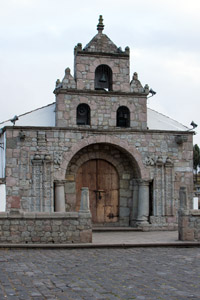
(Riobamaba, Chimborazo, Ecuador)
We were met at 0600 by our guide Paul, a driver and another guide who seemed to be coming along for the ride. Our first stop was a rather impromptu visit to Iglesia de Balbanera, Ecuador's oldest church near Cajabamba. We then set off for Aluasi, about an hour and a half down the road, from where we would ascend into the hills to find our starting point.
The journey was not without incident. Close to the end we met a police road block. Our driver and the other guide got out. We thought it would be done and dusted in a minute. But as we waited in the car we began to realise not all was right. We eventually got out, and the story we got was that our driver had a problem with his license which was dealt with long ago but now the police were demanding money. I was not sure about this but after about half an hour we were allowed to get on our way.
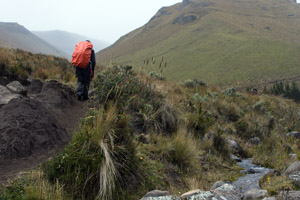
(Sangay NP, Chimborazo, Ecuador)
After breakfast at Aluasi we started ascending into the hills to our starting point Achupallas . But again it was not totally smooth and we took a wrong turn somewhere. We ended up having to traverse the mountain stopping at every house for directions. By the time we drew up at the house where our mules were waiting we were perhaps an hour late.
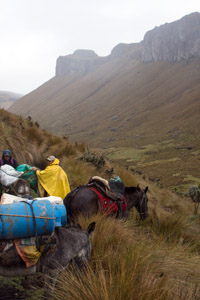
(Sangay NP, Chimborazo, Ecuador)
Not to be deterred we set off up into the hills. It started well but as we slowly climbed up a valley the clouds started to gather. It was probably not drizzling all the way up but it seemed that way. There was at least one sunny moment when we reached a small lake at the head of the valley. More annoyingly we were not following the Inca trail. Apparently somebody had prevented people from taking the first part of the Inca trail so we were forced to go up another valley.
As we got towards the pass which would get us in the right valley the heavens really started to open and our energy ran out. We had been walking straight uphill for five hours and we were exhausted. Since we had not reached our intended destination a camp site slightly sheltered by a lip was selected and the guys put the tent up. When I say guys we had three people with us our guide Paul, a donkey man who looked after the two donkeys (carrying the tent and cooking) equipment and another guy with a horse. We were a bit puzzled about why we needed a horse but would find out later. We had dinner in the tent and then went to sleep with the rain lashing hard against the tent.
Monday, 23 July 2018
Camp site 2, Sangay National Park, Canar, Ecuador
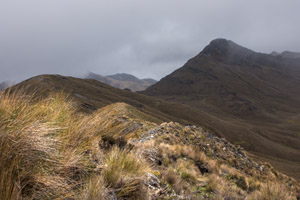
(Sangay NP, Chimborazo, Ecuador)
It was not a particularly good night. Given the last minute nature of our camp site our tent was pitched at quite an angle so we spent most of the night rolling into each other. We got up and had some breakfast and then set off. This was to be a much better day, first we had to climb up to a ridge and then we walked along it getting savaged by the wind. After three hours we got to Tres Cruces and had an early lunch in a sheltered spot overlooking the lake.
From this point it was about four hours up and over a 4300m pass to our next camp site. We finally met the Inca trail which in places was wide and rocky, but in others became boggy and indistinct. At one point there was some excitement when we met three park rangers. They were looking for a party who had been camped above us at Tres Cruces and had sent an SOS message. We still do not know whether they found them but it highlighted how bad the weather had been the previous afternoon.
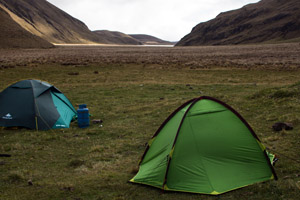
(Camp site 2, Sangay National Park, Canar, Ecuador)
The flora was amazing with lots of alpine flowers including cyclamens growing everywhere. We were able to navigate the bogs through this amazing cushion plant, which grew everywhere in clusters of five leaved rosettes which always provided you a dry place to put your foot.
Finally around 1500 we got to the head of the valley where Paradones, an Inca ruin, is located. After seven hours walking we were tired so opted not to carry on and pitched the camp next to a small stream. This time we were able to pitch the tent on a near flat spot. It was almost completely dry so we were able to watch the sun light up the valley as we had our dinner and settled in for the night.
Tuesday, 24 July 2018
Cuenca, Azuay, Ecuador
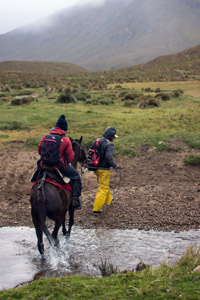
(Sangay NP, Canar, Ecuador)
We had a much better night's sleep and got up early as we had a lot to do. After breakfast we left Paul to pack up the camp and set off with the horseman. Just down from the camp site the horse finally came into use. There was a broad deep stream which had no way of crossing, so we took it in turns to ride on the back of the horse across the stream. In similar situations on other treks we have waded barefoot to the other side, but in this case we took the easy option.
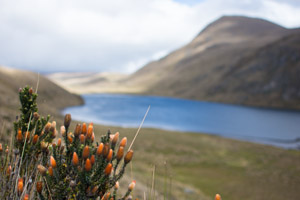
(Sangay National Park, Canar, Ecuador)
From the stream we went slightly uphill to follow the Inca trail along the side of the valley. We had a bit of excitement in the form of a bull which was excited by our presence. It was very much a classical black bullfighting toro with pointy horns. The horse man soon saw it off by shouting and throwing rocks. After an hour or so we were at the side of Laguna Culebrillas and from here it was a short walk up to the ruins at Paradones.
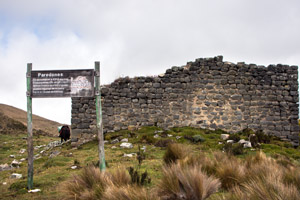
(Sangay National Park, Canar, Ecuador)
Paredones was very atmospheric perched on the side of a valley that would not have looked out of place in Scotland. It had three rooms and a couple of the classic trapezoidal door frames the Incas are noted for. The sun was out so it was a nice place to stop and relax. It was a chaskiwasis or stopping point for the chasquis, or couriers, who used to run relay to transfer messages up and down the Inca empire. Using this system messages could be transmitted 250 km a day, thus a message could theoretically reach Quito from Cusco in ten days. We however were not running anywhere!
After Paredones the Inca trail was very broad, obvious and easy to walk along. It cut across the moors and we needed to follow it for a couple of hours to get to a town called San Jose where a jeep was waiting for us. The donkeys had not followed the same path as us but a while into the walk they caught up with us and we swapped the horseman for Paul as none of the animals were allowed to walk on this section of the trail. The scenery was very redolent of Dartmoor and indeed after a while the mist closed in and we briefly appeared to be lost. The other treat was a river which appeared to flow uphill.
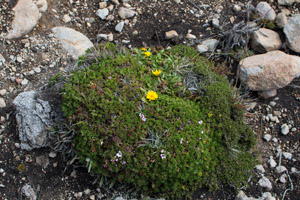
(Sangay National Park, Canar, Ecuador)
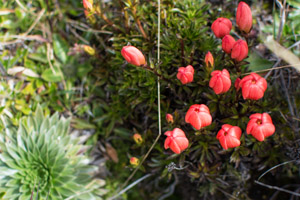
(Sangay National Park, Canar, Ecuador)
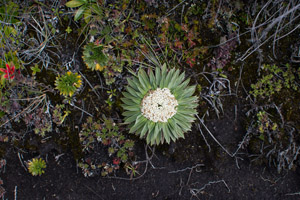
(Sangay National Park, Canar, Ecuador)
When we got to San Jose we were very happy to see the jeep. It was drizzling so we all piled in and drove down to Ingapirca. The ruins at Ingapirca are an amalgam of a previous culture the Canaris, who had built a temple on a prominent rock, and the Inca who rebuilt it with an entire complex round it. We had a quick bite to eat and then walked round the ruins.
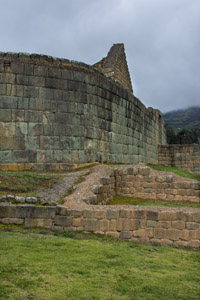
(Ingapirca, Canar, Ecuador)
As usual the masonry was amazing, no mortar was used and you could hardly slide a lolly stick between any two blocks. There were some grain stores and several bath houses. There is apparently an underground water system but we never saw it.
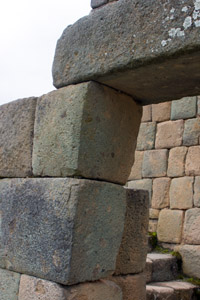
(Ingapirca, Canar, Ecuador)
After an hour or so we got back into the jeep and drove to Cuenca . The second city of the Ecuadorian Highlands Cuenca was again an Inca town which was said to rival Cusco at its peak. However by the time the Spanish arrived it was abandoned. The Spanish rebuilt it in a colonial style, and it has some of the most amazing cathedrals in the country.
We had an interesting time getting to our hotel as the roads are so narrow in Cuenca that they are all one way traffic jams and unless you are lucky to find a parking space you cannot stop without holding up the traffic. We again had a room in an incredibly nice courtyard hotel with polished wood floors and wrought iron railings. However our room was completely internal and whilst very nice proved to be a bit stuffy.
For dinner we were determined to try one of Ecuador's specialities Cuy (guinea pig) so we booked ourselves into a restaurant that was well known for it. I would not say it was the nicest thing ever, more crackling than meat, but you have to try these things.
Wednesday, 25 July 2018
Cuenca, Azuay, Ecuador
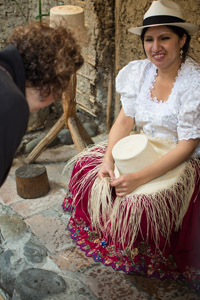
(Cuenca, Azuay, Ecuador)
We had planned a day of pottering around and did just that. We started off by going to a Panama hat factory. It is perhaps not a well known fact that Panama hats have always been made in Ecuador. They only got their name when they were exported for the workers on the Panama canal. The Homero Ortega factory is a very interesting place to visit and they take you through the whole process from weaving to shaping. Then naturally you have the opportunity to buy one, which we did.
Out of the hat factory we then went to the Cathedral of the Immaculate Conception to climb to the roof terrace to get a view over Quito. This was pretty impressive, the blue domes of the cathedral providing a nice contrast to the red sandstone of the church. After this we went for a walk along Cuenca's central river which is quite powerful so provides a nice breeze on a hot day. It was not however a hot day so we just stopped for some lunch at a brewery pub then headed back to the hotel.
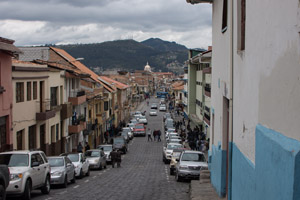
(Cuenca, Azuay, Ecuador)
Late afternoon we jumped in a taxi and headed to the South of Cuenca to Turi hill where a small chapel overlooks the whole town. After taking a few pictures we found a cocktail bar with the same view but inside which was good as the temperature was rapidly plummeting. We had arranged with the taxi to pick us up at a certain time, but ten minutes after that time he still had not appeared so we leapt in another taxi back down the hill.
That night we branched out a bit and went to a jazz club for a pizza and some music. Interestingly it was entirely run by ex-pat Americans and all but one act was American. The standard was very high and the pizza not bad too.
Thursday, 26 July 2018
Riobamba, Chimborazo, Ecuador
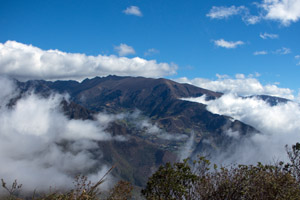
(Riobamba, Chimborazo, Ecuador)
We spent the morning pottering about Cuenca first going to an American cafe for breakfast and then buying another Panama hat as a gift. Then we jumped on the bus back to Riobamba to pick up our luggage.
The journey from Cuenca to Riobamba takes six hours but is very scenic. We had effectively skipped two hours of it by walking 40km through the mountains. Whilst it sounds unbelievable that a bus only progresses 40km in two hours it's a result of the road through the mountains being so winding. There were no bridges or tunnels to cut the time down, you just have to sit and watch as the scenery goes by.
We were dumped at the outskirts of Riobamba at around 1930 and so had to get a taxi quite a way to our hotel. Here we were reunited with our luggage and once we had repacked we headed out for dinner.
Friday, 27 July 2018
Chugchilán, Cotopaxi, Ecuador
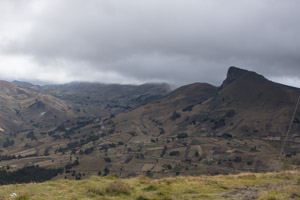
(Tigua, Cotopaxi, Ecuador)
Our guide Paul picked us up at 0700 for the next part of our trip to the Quilotoa region. We had originally planned to do another high altitude hike local to Riobamba but the weather was not great so we had decided to instead head a but further North to a region with some great walking at lower altitudes. The first two hours of the drive were a fairly mundane journey back up the Pan-American to Latacunga but at this point the adventure started.
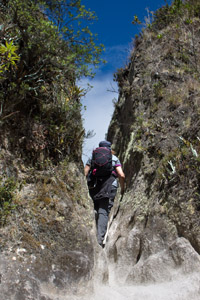
(Chugchilán, Cotopaxi, Ecuador)
From Latacunga a road winds up into the mountains eventually leading to the crater of Quilotoa volcano. The first stop of interest is Tigua where Indians attempt to sell you handicrafts. The paintings were the most tempting, very colourful miniatures which really did not cost a lot and depicted Indian village life with plenty of volcanoes and llamas in the background. We did not however buy anything.
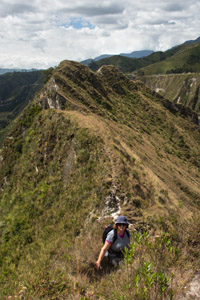
(Chugchilán, Cotopaxi, Ecuador)
After Tigua the next village was Zimbahua which is a regular market town. After this the road follows an incredibly dramatic gorge cut into the volcanic ash before ascending to the crater of Quilotoa. As we were following the road we did not get to see inside the crater and instead carried on over and down to Chugchilán and our next hotel the Black Sheep Inn. This turned out to be a very nice eco-lodge nestled part way up a natural amphitheatre of forest and farmland. It has several buildings dotted around the trees. It is almost paradise if you can overlook some of the eco touches like composting toilets and having to flush the urinals with a jug of water. The weather however was gorgeous thanks to a mysterious micro climate.
After we had settled into our room we set off on one of the well signposted walks around the inn, the "skywalk". This started out a bit of a misnomer as we descended into a side branch of the massive gorge cut into the volcanic ash which Chugchilán sits on the lip of. Working our the way to the bottom down steep paths of volcanic sand took some effort. When we finally got there we found a narrow floor of grass dotted with huge Tufts of pampas grass. We worked out way down the gully and it was only an hour into the walk when we started to realise why it was called the skywalk.
The path steeply ascended to the narrow blade which separated ours from the main gorge. At the top we had to squeeze through a narrow gap to find ourselves on a very narrow path atop the ridge. It was ridiculously narrow, for about 100m the path was the width of the ridge, with very sheer drops either side. Anna was reduced to crawling on her hands and knees until we reached a small plateau like wild meadow where there was sufficient room to sit down and have lunch. Then there was another bit of narrow path before reaching some farmer's fields and the main plateau. After this it was another hour of hiking before we found ourselves back at the start of the walk. There was some brief excitement with some dogs but we had come armed with sticks and managed to discourage them from biting us.
After the walk we hung out on one of the many balconies of the hotel and then had dinner. It was a very communal affair and we got to chat to many of the other walkers who were staying there. Interesting a lot of them were following a trail which involved walking six hours a day for three days between hotels. Had we more time we would have liked to have done this. Nevertheless we went to bed very tired.
Saturday, 28 July 2018
Chugchilán, Cotopaxi, Ecuador
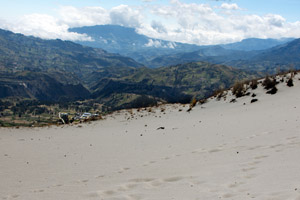
(Quilotoa, Cotopaxi, Ecuador)
We had opted to take a truck up to the rim of Quilotoa and then walk our way back to Chugchilán. We were given very in depth instructions and shared the truck with a Dutch family of four. At the rim we were able to avoid nearly all the tack tourist shops and snack bars and got to the viewing platform. Here we finally got to see what we had come all this way to see, the amazingly deep and blue crater lake of Quilotoa . Formed in the 13th century and last erupting in the 18th Quilotoa is a fairly recent crater so is tinged with jagged peaks.
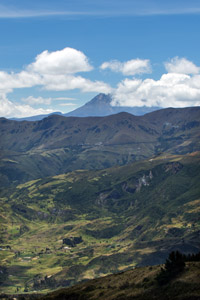
(Chugchilán, Cotopaxi, Ecuador)
From the viewing platform we walked a third of the way around the rim in about an hour and a half. This was through an amazing landscape of scrub, pine forest and sandy beaches of golden volcanic ash. At this point you descend down a road and occasional short cuts to a small village. We had met an English couple at the rim and they had managed to have a dog follow them up from this village. Somehow we agreed to have this dog foisted on us for our trip down but fortunately we managed to give the dog the slip.
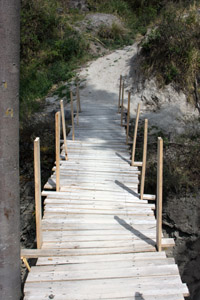
(Chugchilán, Cotopaxi, Ecuador)
From the village you descend into the gorge which separates it's plateau from the plateau Chugchilán is located on. This is one of the toughest parts of the six hour walk as the sandy paths are very steep and at one point you have to cross a landslide. It is also a bit demoralising as at one point you can see your destination a few hundred metres away but as you descend it gets further away. Finally we got to a very crude bridge at the bottom of the gorge and started our ascent. This seemed to take forever but finally, at around 1500 we reached the inn.
After this we had a wonderful afternoon in the sun and around 1700 retreated into our room to put on the log burner, it gets cold quickly. We then had another convivial night around the dinner table mainly talking to a French couple who were walking the three day trail.
Sunday, 29 July 2018
Quito, Pichincha, Ecuador
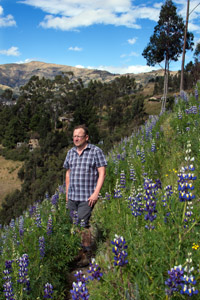
(Chugchilán, Cotopaxi, Ecuador)
Getting up relatively early we decided to walk another trail, the Ridgeway, before our driver was due to turn up at lunch. This was a much simpler hour and a half up the side of the inn past some farms to a road perched on the ridge above. Then round the horizon for about half an hour before descending a near vertical field to the road below the inn.
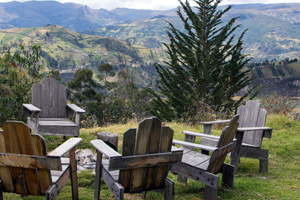
(Chugchilán, Cotopaxi, Ecuador)
When we got back there was time for a bit of reading before Paul arrived to take us to Latacunga. This was a fairly uneventful reversal of the route we took to get there. We were dropped at the bus station in Latacunga and immediately boarded a bus to Quito. The only two things to note were: once again we did not get to see Cotopaxi as it was covered with cloud; and also the on board entertainment on the bus was Speed, which was pretty unfortunate although I am not sure the bus ever got above 50mph.
In Quito we had an argument with a taxi driver but eventually got back to the original hotel we started our trip in. They were very welcoming and it was nice to be back. Not long after arriving we headed out for a very unmemorable dinner in the Mariscal, it was Sunday and most of the good options for dinner were shut.
Monday, 30 July 2018
Maquipucuna Lodge, Pichincha, Ecuador
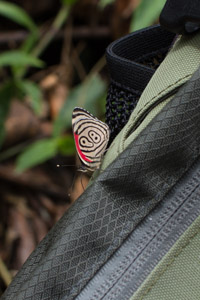
(Maquipucuna Lodge, Pichincha, Ecuador)
Back on plan we were picked up at 0730 by a shuttle from the Maquipucuna Lodge . Maquipucuna is a nature reserve in the cloud forest about two hours north east of Quito. We shared the shuttle with two people from Tucson who had just spent three weeks taking a university class to the Galapagos Islands. They were keen bird watchers and we started to wonder what we had let ourselves in for.
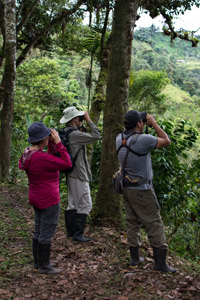
(Maquipucuna Lodge, Pichincha, Ecuador)
Out of Quito the people carrier followed the road to the coast. We descended through a river valley that increasingly got more heavily forested. After an hour it turned off first onto a paved track and then finally to a dirt road along a river. When we finally got to the lodge it was around 1000. We met their naturalist Mauricio who almost immediately equipped us with a pair of wellies and took us out bird spotting.
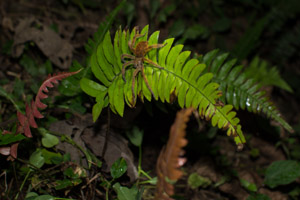
(Maquipucuna Lodge, Pichincha, Ecuador)
At this point I should say that we were just there to enjoy the cloud forest and hopefully find a spectacled bear, the only bear species native to South America. However there were a lot of birds and the only other people in the lodge, Dave and Katrina from Tucson, were quite good company. So we went along with them and Mauricio and looked at all sorts of things through the binoculars, but mainly birds.
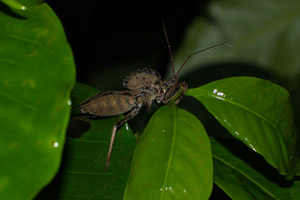
(Maquipucuna Lodge, Pichincha, Ecuador)
This initial session was quite quick, we then had lunch and went out in the afternoon. There was nowhere near as much excitement in the afternoon as a lot of the birds were asleep but again it was good to see some of the forest. Around 1700 we returned and after a short rest we had dinner in the lodge and for some reason agreed to go out with everyone on a long expedition starting at 0600.
After dinner we had organised to go out on a night safari. We had done this a few years ago in Costa Rica so knew how to find spiders - and we found hundreds. The trick is to have a head torch, you then look our for the eye shine I remembered spiders eyes were green and moths are orange. We also found a very odd sail backed dinosaur bug, a type of wheel bug, which I only identified with help from the Royal Entomological Society. After a while it started to pour down with rain so we had to beat a hasty retreat without finding a Kinkajou.
Tuesday, 31 July 2018
Maquipucuna Lodge, Pichincha, Ecuador
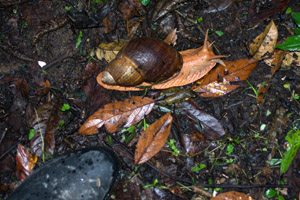
(Maquipucuna Lodge, Pichincha, Ecuador)
Having breakfast in the dark at 0600 in Wellington boots and plastered in mosquito repellent is perhaps not everyone's idea of a holiday. However we had a lot of fun that morning, hiking 4.5km up into the primary forest. We saw a lot of things including gigantic snails and a snail kite which ate them, a quetzal, a choco toucan, crimson rumped toucanet, barred puffbird and many other bird species.
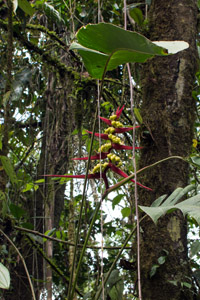
(Maquipucuna Lodge, Pichincha, Ecuador)
Whilst the first three kilometres was in secondary forest regrown over farmland bought thirty years ago by the reserve, the last section was in original or primary forest. The vegetation here was gob smacking. Everything competes to get sunlight so every tree is covered in creepers and bromeliads. Even the leaves of the parasitic vines are themselves covered in parasitic lichens. We stopped at the top of a hill where we were able to get a view over the next valley. Whilst the others tried to spot birds, I watched a hummingbird flitting around the area behind us seemingly trying to get attention.
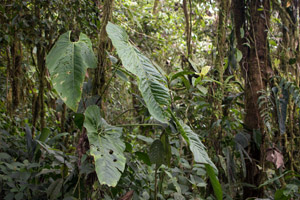
(Maquipucuna Lodge, Pichincha, Ecuador)
We had not seen or heard a bear so we turned back after the brow of the hill. We were making our way down when Mauricio thought he heard a bear. He led us quietly into the undergrowth, it was pretty hard going. Eventually, a bit sweaty, we concluded that we were not going to find it and turned back for the lodge. We made it back for just before 1300 and had lunch.
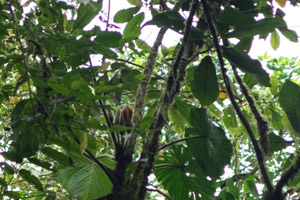
(Maquipucuna Lodge, Pichincha, Ecuador)
We could have donned our wellies and gone out again that afternoon but we decided having gotten up at 0600 we had done enough and it was time to enjoy the holiday. We opened up our balcony which hung over the river and sat and read for the afternoon. Even then we could not avoid bird spotting, our shower had one way glass looking out into the forest and an orange bellied euphonia seemed to be permanently stationed there. Whether it was looking at itself in the mirror was not clear but Anna christened it the "pervert bird".
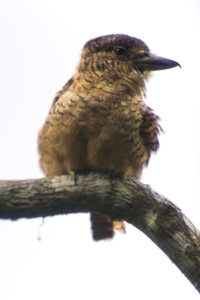
(Maquipucuna Lodge, Pichincha, Ecuador)
That night there were a lot more people for dinner. The owners of the hotel Rodrigo and Rebeca had turned up from Quito. They were very entertaining and in a very good mood because the whole area Choco Andino de Pichincha had been awarded UNESCO World Biosphere status on the 25th. They told us how the reserve was built, originally farmland it was put up as collateral to a loan by the bank where Rodrigo worked. When the loan turned bad they saw the opportunity to do something with it. Rebeca also regaled up with her recollections of growing up in a Catholic school in Matlock Derbyshire.
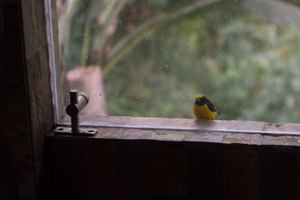
(Maquipucuna Lodge, Pichincha, Ecuador)
One thing that was interesting were their thoughts on Rafael Correa, Ecuador's populist/socialist president in power from 2007 to 2017. He had allied himself with Venezuela's Hugo Chavez and had been enormously popular with the people. However he had been disastrous for charities like Maquipucuna as he had opposed foreign investment by NGOs and the IMF. In addition a large part of his strategy to make Ecuador more independent had relied on drilling for oil hence endangering a lot of pristine forest. We went to bed very informed.
Wednesday, 1 August 2018
Otavalo, Imabura, Ecuador
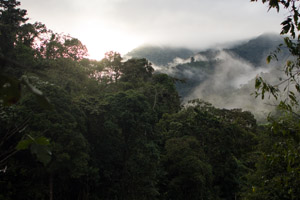
(Maquipucuna Lodge, Pichincha, Ecuador)
We again got up at 0600. The idea was that the lodge's tracker had gone out early to find the bears for us. So we just poked around the immediate vicinity of the lodge until breakfast. We then went out again and followed the regular trail and found a few more birds. We got a certain distance but we were getting a little bored of going up the same trail, so when it got to 1100 we said we would make our way back to the lodge. We figured there was no chance of seeing a bear and our car to Otavalo was leaving at 1400.
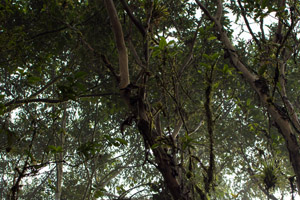
(Maquipucuna Lodge, Pichincha, Ecuador)
We made our way down a trail which dipped quickly into the river valley. I would say this was one of the most pleasurable walks as we felt we were exploring on our own, cutting through vast glades of bamboo and listening to the sounds of some very large birds crashing through the canopy above. We were almost at the end of the trail and looking forwards to a shower when we were surprised by the bear tracker running down the path towards us yelling "bear, bear". We first thought he was being chased but when he caught up with us he told us that the others had found a bear literally five minutes beyond where we had left them. There was some doubt at first but he had run all this way so we decided to head back. A few minutes up the track Rebeca's daughter also turned up having run all the way from the lodge. It had taken us forty minutes to get down to where we are, we managed to get back in about fifteen.
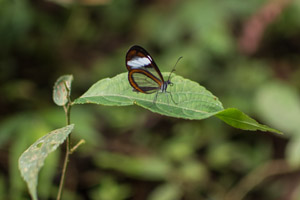
(Maquipucuna Lodge, Pichincha, Ecuador)
All the effort was really appreciated and we got there just in time to see the bear moving around. We were all trying to be quiet and the bear seemed to be settling down, breaking branches off a tree to create a nest then climbing into it. I only had a fixed 35mm lens with me so was very lucky that Richard, a fifth guest, had turned up that morning with a zoom lens (it is his picture below). Finally after three days of effort we had found a spectacled bear, an almost endangered species - a Paddington bear in "darkest Ecuador"!
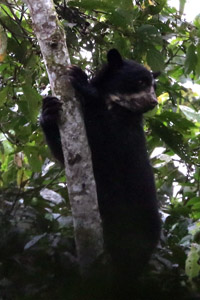
(Maquipucuna Lodge, Pichincha, Ecuador)
We spent a while observing the bear so consequently we had to run down the hill to have a shower and then lunch before leaving. We said our goodbyes and then jumped in a car with a driver who would take us to Otavalo our next stop. It was again an amazing journey, up through the cloud forest to the outskirts of Quito and then down the Guayallabamba river canyon. We drove through Tabacundo where a lot of the country's flowers are grown in vast poly tunnels below the volcano of Cayambe. Cayambe is the highest mountain in terms of distance from the Earth's centre because even though it is only 5790m high it lies on the equator. Finally we dropped into the valley where Otavalo sits, encircled by the four volcanoes of Mojanda, Cayambe, Imabura and Cotacachi.
It would have been incredibly dramatic were it not for the fact that it was raining heavily in the valley. The driver took us up to our hotel the Casa Mojanda, perched on the slopes of a volcano 4km from Otavalo and we quickly scurried into our room. The hotel was well prepared for the cold weather, and the rooms styled on adobe houses of Santa Fe each had a kiva fireplace which would be roaring away later that night. We were running late for dinner so quickly changed and walked over to the main building of the hotel. Again the hotel was not running at maximum capacity and the only other guests were an older American couple coincidentally from Santa Fe itself. We chatted to them for a while over dinner and then Betti, the owner of the hotel and an ex-pat from Brooklyn turned up. We went to bed not too late, the room had been nicely warmed by the fire and we listened to the rumbles of distant thunder as we went to sleep.
Thursday, 2 August 2018
Otavalo, Imabura, Ecuador
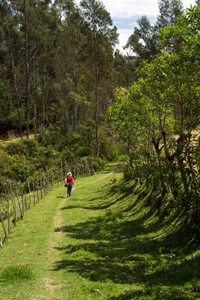
(Otavalo, Imabura, Ecuador)
The next morning all traces of the previous nights storm had disappeared. The sky was blue and there were clear views over to Imabura the volcano opposite us. We had decided that morning to walk the four kilometres down to Otavalo and so set off after a pretty late breakfast. It was a very bucolic walk down through fields and a green river valley to the outskirts of town. About half way down we overtook the couple from Santa Fe. They had the classic problem that one of the dogs from the hotel had followed them and now they were in a quandary about how to return him. We tried to help but the dog was very stubborn, in fact they ended up taking him back in a taxi to the hotel when they got to the bottom!
Otavalo is known for its indigenous market and as we got closer to the centre of town the number of craft stores bloomed. It was actually quite good not going there on a Saturday as the number of tourists was minimal and a lot of the stalls were keen to sell. We had a sandwich and a cup of tea at a very westernised bakery on the market and then carried on exploring. In the end we made very few purchases as although there were lots of ponchos etc they were just a bit too ethnic to be serious gifts for people.
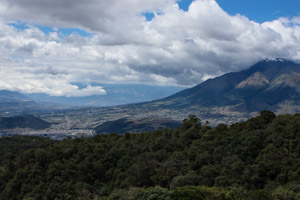
(Otavalo, Imabura, Ecuador)
As well as buying presents we set ourselves the rather unnecessary job of posting a panama hat we had bought in Cuenca. I say unnecessary because I was worried about the amount of hand luggage on the return flight but in the event at least twenty people were carrying exactly the same boxes back with them. Anyway we piled into Otavalo's post office and then went through a long process of form filling and customs declarations. While we were there a very strange American woman, who had clearly gone native, turned up with a jacket plastered with anti-Monsanto logos and started arguing with the officials. I toyed with the idea of telling her the company had merged into Bayer and so she may have to get a new jacket.
We spent the rest of the afternoon exploring the markets and stayed in town for dinner, eating pizza at a restaurant in a Dutch run guest house. We needed a break from Ecuadorian cuisine and it was a really nice pizza. By the time we took a taxi back to our hotel the fire was roaring in our room and we fell asleep immediately.
Friday, 3 August 2018
Otavalo, Imabura, Ecuador
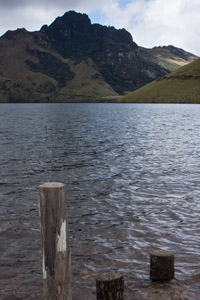
(Otavalo, Imabura, Ecuador)
Again we woke up to glorious sunshine and went down to have breakfast looking at Imabura opposite. We had decided to go to Mojanda lakes , three crater lakes at the top of the volcano our hotel was on. This took a bit of negotiation as it was a half an hour taxi ride with the taxi driver hanging around for a couple of hours at the top while you walk. In the end I think we left around 1100 and were up at the top at 1130. It was pretty bleak up there, in what is called the páramo. No trees and endless tufts of grass with not much in the way of colour. Karikucha the main lake was dramatic but pretty cold looking and we walked down one side of it and over a ridge to find Yanakucha, another of the lakes. We then came back the way we had come and got to the taxi after about an hour and a half of walking.
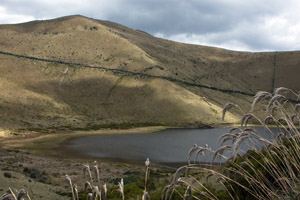
(Otavalo, Imabura, Ecuador)
Unlike the top of the volcano it was sunny at the hotel and so we slumped into deck chairs on our private terrace and sat there soaking up the rays. We could have gone into town but it was our last afternoon in Ecuador and we did not feel the need. Apart from days spent on a bus I imagine we had walked at least four hours every day so we felt justified in finally resting. The terrace was not entirely private, after about half an hour the hotel dogs found us and collapsed in the sun next to us.
That night we dined in the hotel with the couple from Santa Fe. Betti again joined us and it was quite a lively conversation. She was fairly left leaning in her views which given what the republican right was up to in the states was hardly surprising. We got onto the subject of Correa and found she had a totally different view to our previous hotel owner. Yes he had severed a lot of the ties with the US and the outside world but that was a good thing. Lenin Moreno, the current incumbent, had apparently gotten in on the understanding that he would continue a lot of the policies but then switched sides to rekindle relations with the big banks. Later on she regaled us with a few wilder conspiracy theories including that of the US Air force weaponising the weather, I did not mention the fact that HAARP had been unsuccessful and had been shut down in 2014. We got to bed relatively late and again feel asleep to the sound of the crackling fire.
Friday, 3 August 2018
Otavalo, Imabura, Ecuador
The next day we did not get up to much as we were leaving at 1100. It had rained heavily overnight and Imabura had a fairly thick new dusting of snow. We had a leisurely breakfast and Anna and Betti started chatting and playing the piano. In fact when our driver arrived it was quite an effort to get Anna to leave. We then drove back south to the airport, arriving ridiculously early and finally leaving at around 1600. Apart from a fairly entertaining night in Amsterdam it was the end of our holiday!





